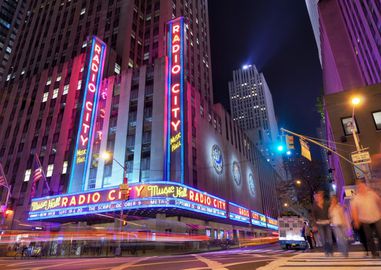

Although formally Radio City Music Hall is part of the Rockefeller Center complex, it has a reputation of its own and is therefore worthy of a separate description.
Built in 1932 in the Art Deco style, it derives its name from its first owner: the Radio Corporation of America (RCA). It is one of the most popular stages in the American entertainment industry, hosting not only concerts, musicals and plays, but also award ceremonies, circuses and TV shows. Radio City's first show featured the legendary American dancer and choreographer Martha Graham. However, this highbrow performance did not make any resonance among the theatergoers, who had been accustomed to more down-to-earth spectacles, and so the Music Hall transformed into a mass G-movie theater that offered fast-paced shows before the screenings. This film & stage format, which included four daily shows, lasted until 1979. Since the films were designed for a specific audience, mostly children, New York's blossoming movie theater market forced Radio City to close. At first Radio City's executives wanted to transform the theater into office space, but after the protests of some heavyweight show-biz stars, including John Belushi, the theater was preserved for entertainment purposes. In 1980 it was renovated inside and reopened to the appeased public.
Today Radio City has a 6,000-seat auditorium with a glowing arched proscenium made of aluminum, glass, leather and chrome. The interior was designed by Donald Deskey and the building itself by Edward Durell Stone. The arched stage, alluding to a celestial sphere, measures 66 x 144 feet and indeed creates a strong impact when you enter the premises.
The Music Hall's most cherished treasure is the Mighty Wurlitzer pipe organ, whose 4,410 pipes line the walls of the proscenium. Two identical consoles with four keyboards stand on both sides of the stage. It was installed at the very beginning and happens to be the largest pipe organ ever built for a movie theater.
From 1980, the year of Radio City's renovation, the theater has hosted the performances of all the major international rock and pop stars, as well as classical musicians, comedians, magicians, and other artists. It has also served as a stage for America's leading award ceremonies, such as the Grammy Awards, the Tony Awards and the MTV Video Music Awards. The Grammies, however, moved to Los Angeles in 2004, due to Hollywood's relentless push to monopolize America's entertainment industry.